Removing moles and warts is not a difficult operation for either surgeons or patients. It is carried out without hospitalization and as planned. Preliminary examination and modern methods of intervention virtually eliminate postoperative complications.
Healing
A wound is formed at the site where the mole was removed immediately after the operation. Depending on the method of eliminating the defect, either a clear narrow scar or a spot appears on the skin. In most cases, a crust forms in the area where the skin was cut with a scalpel, damaged by laser, liquid nitrogen or electrical exposure. This is a protective reaction of the body aimed at closing an area vulnerable to infection. In the first week - ten days, it is not recommended to carry out any physical impact on the area of the operation. Maintaining the integrity and tight fit of the crust to intact skin protects against infectious complications. Therefore, you should refrain from rubbing, applying bandages and plaster, or rubbing creams. Especially towards the end of the first week, patients are bothered by itching, which causes involuntary peeling off of the crust.
Important! Premature removal of the crust from the wound is fraught not only with infection and an increase in the recovery period, but also with the formation of a more noticeable scar at the site of the operation.
Scar Formation
After removal of a mole, a scar begins to form under the crust. After falling off, young pink skin is found in its place. At first, the scar is painful upon contact, then increased sensitivity, and over time, unusual sensations when touched disappear, and the elasticity of the tissue is restored.
The appearance of an uncomplicated scar also does not cause concern: the pink surface fades over time, the level of the scar is leveled with the general level of epithelial tissue, the skin looks healthy, and the site of damage is not noticeable. Complete healing of the wound surface occurs after removal of the mole in about a year. The scar at the site of surgical treatment or the area of non-invasive treatment is hardly noticeable by this time and practically does not stand out.
Complications
In rare cases, the restoration of the integumentary tissue does not go so smoothly.
Cosmetic defect
If for some reason the wound does not heal by primary intention (multiple removal of the crust, repeated trauma to the surgical site), then the scar is not so flawless. The connective tissue spreads over a larger area, and there is a strong decrease in elasticity, which means limited mobility. But, sooner or later, in this case too, the functions will be restored, and healing will occur fully.
Keloid scar
An even rarer complication after mole removal is a keloid scar. This is a very unpleasant consequence that occurs for unknown reasons. It is believed that the following factors can provoke the appearance of excessive skin growths instead of the formation of a neat scar:
- deep damage to the epithelium;
- decrease in the body's immune forces;
- tendency to allergies;
- special conditions, for example, pregnancy, puberty.
But the most significant reason for the occurrence of a keloid scar is considered to be a genetic predisposition. In this case, a hypertrophied growth can occur even without visible tissue damage (in this case we are talking about a tumor of keloid origin) or at the site of the smallest scratch.
Stages of keloid development
A keloid scar does not form immediately after removal of a mole. Against the background of textbook healing, after a year, and sometimes more, the tissue on the scar begins to grow. The connective tissue appears inflamed (red or pink), and the volume quickly increases. The surface of the scar is smooth, but uneven, protruding above the skin by 8 - 10 mm.
The formation of a scar and its growth last on average 2 – 3 years, but can last up to 5. During this time, the fibers of the growth become coarser, and in case of accidental injury, screeds and excessive skin tension are formed. Then the scar stabilizes and remains unchanged for many years. Its increase in a stable period is provoked by accidental repeated damage, constant physical or thermal exposure.
Treatment of postoperative scars
Uncomplicated healing processes after mole removal do not require special therapy. In some cases, a dermatologist may recommend emollient ointments and creams; in case of a large healing area, a course of physiotherapy is prescribed.
Keloid scar is a complex case. On the one hand, any physical impact can provoke rapid growth of connective tissue. On the other hand, in the absence of treatment, a significant cosmetic, physical and functional skin defect develops. Therefore, in each specific case, dermatologists resort to individual schemes for restoring skin smoothness. Doctors have the following tools in their arsenal:
- absorbable ointments (“Karipain”, “Kotnraktubex”, etc.) - daily rubbing, applying bandages;
- corticosteroids (“Triamcinolone acetonide”, etc.) – injection of a suspension of the drug into the growth approximately once a month;
- physiotherapy (electrical and phonophoresis with the flow of ions of absorbable agents into the tumor area);
- constant grinding of the skin surface - effective at the first signs of a keloid or after its surgical removal;
- excision of scar tissue with subsequent prevention of an increase in the amount of scar connective tissue;
- tight bandaging (bandage) with absorbable agents at the first signs of overgrowth.
Important! Keloid scar is a chronic phenomenon that requires periodic courses of treatment. But with age, aggressive tissue proliferation gradually decreases, and after 40 years it is much less common than in childhood and youth.
The positive point in this situation is that keloids are not prone to degeneration into a malignant tumor.
Thus, the scar after mole removal in the vast majority of cases is neat and does not cause trouble to the person who underwent the operation. In rare cases of excessive scar growth, the dermatologist will select a treatment that is recommended to be strictly followed.
Video: Laser removal of scars and scars
The desire to get rid of moles is due to both aesthetic discomfort and potential danger. Bleeding from a mole, inflammation, increase in size - all this can lead to transformation into a malignant tumor. To get rid of the tumor, many people opt for laser removal.
Benefits of laser removal
Having decided to undergo laser removal of tumors, their owners ask questions about the safety of the method. What are the advantages over other methods?
- painlessness;
- efficiency;
- non-invasiveness (no exposure to surgical instruments - needles, scalpels, etc.);
- sterility;
- fast healing;
- minimum contraindications;
- no scars after surgery.
Modern technologies make it possible to control the process with millimeter precision, quickly getting rid of the tumor. The laser ensures rapid tissue regeneration and does not cause bleeding, reducing the chances of infection.
The procedure is becoming more popular than other methods. The cost of the operation will depend on the choice of medical institution. It is preferable to carry out the procedure in a clinic rather than with cosmetologists.
Indications for removal
You should consult a doctor if:
- the mole grows in size;
- pigmentation goes beyond its limits;
- dryness and flaking;
- hair does not grow on the surface;
- the mole itches;
- the surface is wet or bleeding.
Even if the mole does not have similar symptoms, consulting a doctor will not be superfluous. The specialist will determine the degree of danger of the neoplasm.
Contraindications
Despite the safety of the procedure, it has a number of contraindications:
- skin diseases;
- diabetes;
- suspicion of malignancy of the neoplasm;
- pregnancy and lactation;
- allergy to ultraviolet rays.
The doctor must conduct a mandatory consultation and examination before surgery. Laser removal of a mole in the presence of skin diseases can lead to a number of side effects.
Removing moles on the face
The presence of formations on the face sometimes causes both aesthetic and physical discomfort. Located on the face, it is often injured, bleeds and causes pain. The presence of a large or uneven mole on the face sometimes makes you feel complex about your appearance.
Removing a mole from the skin of the face is the same as from other parts of the body. The neoplasm is examined, the patient undergoes consultation with doctors. Removal, depending on the size of the mole, takes from a few seconds to 5 minutes. In cases where the neoplasm is large, it will require removal in layers. Several days should pass between procedures.
The operation does not leave bruises or bruises, only a wound that will cover itself with a protective crust.
Removing red moles
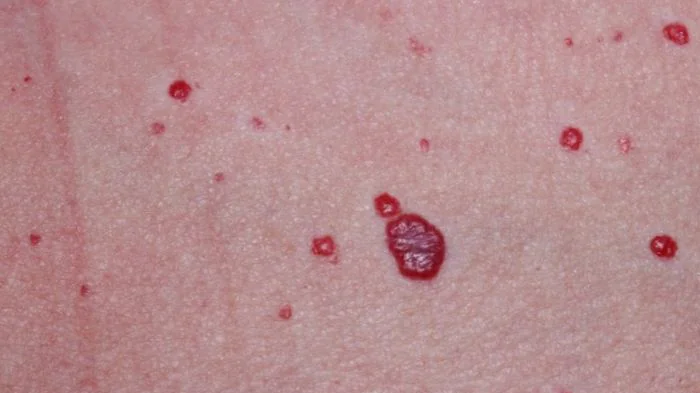
Removal of angiomas is also possible using the laser method. Red vascular neoplasms cause inconvenience when large in size. The nature of their appearance and malignancy are also determined by doctors during the examination. If necessary, the patient is tested for the absence of diseases that may be contraindications for removal.
The removal and healing process is no different from removing a regular mole.
Photos before and after removal
Before surgery, many people are concerned about how the site will look after removal. Below are photos before and after surgery:
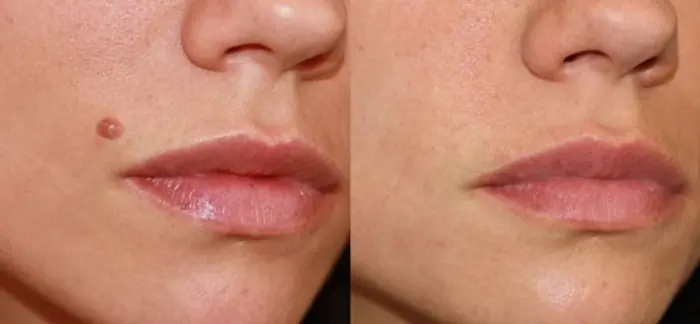
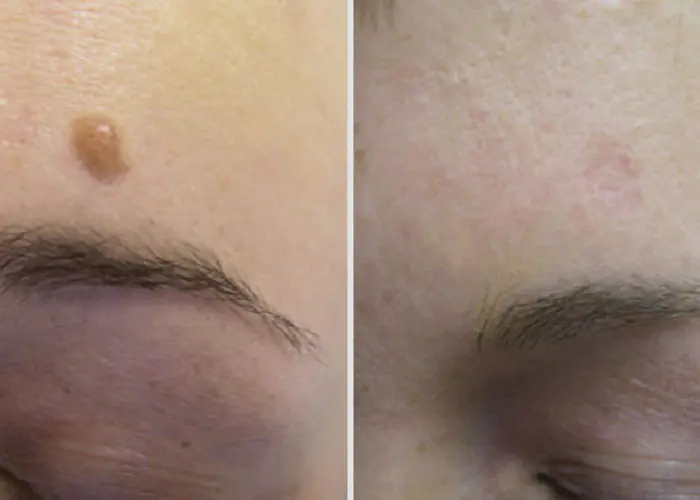
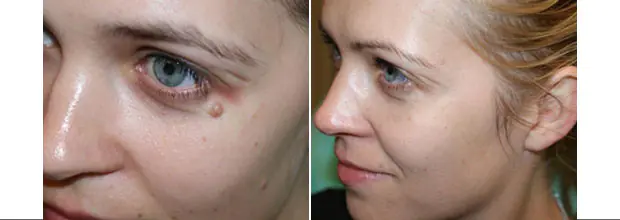
Despite the apparent pain of the procedure, it is performed under anesthesia. The healing process depends on following the recommendations of the attending physician and one’s own responsibility. The after photos are presented after the healing time has passed (from four months to a year).
Video of mole removal
Complete and detailed mole removal process.
Healing process
Immediately after the operation, a scar remains at the site of the mole. The doctor thoroughly disinfects it and gives recommendations for care. During the day after the procedure, a protective crust forms at the site of the mole. Under no circumstances should you get rid of it - it will promote healthy and rapid healing.
For several days after the crust has formed, it may be damp; the doctor will prescribe disinfectants to treat the affected area. The surrounding skin may begin to itch - this indicates the healing process.
Healing time directly depends on wound care, and it is strictly individual. With fast regenerating ability, the process will take two to three weeks, with slow regenerating ability, the process can drag on for months. To speed up the process, special care is required for the affected area.

How to treat a wound after removal
If a bleeding wound opens after removal, tell your doctor. After laser removal, a dry crust of skin should form; disinfectants should be prescribed by a doctor. When the crust falls off on its own, pink skin forms in its place. This will indicate healthy skin healing.
It is not recommended to use cosmetics or other skin products during healing. It is also strictly prohibited to visit swimming pools, baths and saunas. The healing site should not be disturbed with bandages, tissues, sponges or washcloths. As soon as the crust falls off, the skin should carefully protect from ultraviolet rays - use protective creams with a filter of at least 60.
Consequences
If the operation is performed correctly and all doctor’s recommendations are followed, the healing process will accelerate. If a mole is not completely removed, serious skin problems can occur; this risk can be reduced by choosing an experienced specialist. The clinic must be equipped with modern technologies and have a good reputation.
If you do not follow the recommendations within three days after surgery, the skin may become inflamed. The process of treatment and healing of the wound in this case can take a long time. In addition, if you subject the skin to mechanical stress or try to get rid of the crust, a scar may remain.
Prolonged exposure to ultraviolet light on an already healed wound, during the first four months, can lead to skin pigmentation. There is a risk of a new growth appearing in place of the old one.
If all conditions are met, the complete healing process will take four to six months.
Complications after removal
Complications depend on the size of the removed mole and the complexity of the operation. A large wound takes longer to heal, has a greater chance of developing inflammation, and the scar from it takes a long time to heal. When small moles are removed, the chances of complications are reduced.
If the removal took place in several stages, and healing does not occur for a long time after the first operation, the doctor may suggest removing the remainder in other ways.
Complications can arise from incomplete removal of a mole or laser treatment of too deep layers of skin. Incomplete removal leads to the reappearance of the mole. Interference with its functioning, which led to incomplete removal, can lead to the development of a tumor. The new one is removed after the results of the first procedure have completely healed.
Sometimes complications in the form of inflammation or bleeding can occur in women experiencing hormonal problems. Before the operation, a qualified doctor prescribes all types of tests associated with the procedure.
If not properly cared for, pus will form at the scar site. You should not self-medicate; it is better to consult your doctor. A difficult healing process increases the chances of developing a non-healing scar on the skin.
Scars and scars after removal
After four months, a white, sunken surface or raised scar remains on the skin. If the healing process is favorable, the doctor may suggest products that help skin regeneration. If recommendations are not followed or rehabilitation is difficult, the scar may not heal for a long time.
If there are no neoplasm cells and the wound has completely healed, it is possible to visit a cosmetologist. Consult a doctor; laser scar correction can be performed to heal the scar. It takes at least a year for the scar to correct after surgery.
During the rehabilitation process after laser removal of a mole, it is important to follow all the recommendations of the attending physician, not expose the skin to ultraviolet radiation, and undergo regular examinations - this will help speed up the regeneration process.
Moles are present on the body of every person. They are considered harmless. But in some cases it becomes necessary to remove them. This procedure is performed surgically and is safe. Usually it goes away without consequences. But some people have scars or scars at the site of the mole.
Consequences of mole removal
Mole removal is a safe procedure. Modern methods eliminate tumors quickly and painlessly.
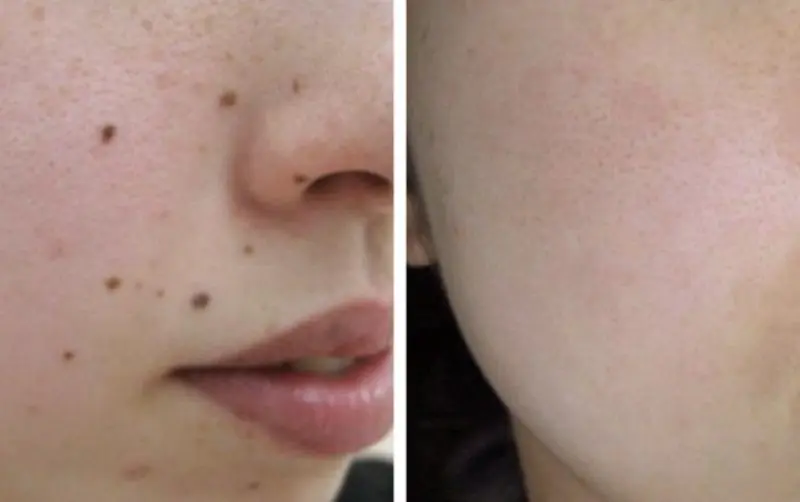
If the necessary examination was carried out before the operation, and the patient follows the doctor’s recommendations during the recovery period, then complications do not arise.
But in some cases, after removal of the formation, scars, scars and pits form on the skin.
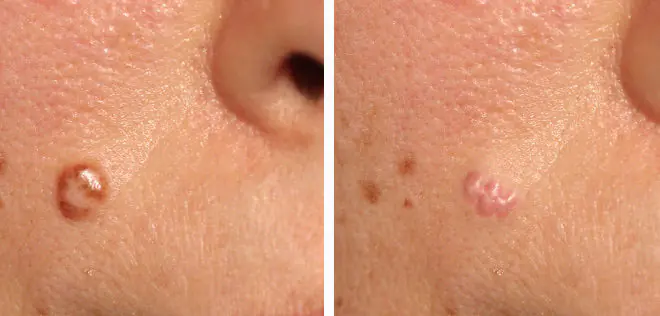
Mechanism of scar formation
Damage to the skin due to injury or surgery usually scars over time, leaving no marks on the body. But under unfavorable conditions, the regeneration process does not proceed correctly. Instead of ordinary cells, fibroblasts are formed in the damaged area. Their accumulations cause the formation of scars.
Connective tissue is denser and more susceptible to ultraviolet radiation. It lacks sweat glands. Keloid scars form from it. They come in two types:
- Hypertrophic. When they form, collagen fibers grow and form a raised scar. It has a larger area than the removed mole. This scar looks like a nodule rising above the surface of the skin.
- Atrophic. In this case, connective tissue is formed in less quantity than necessary. As a result, the dermis contracts, and a depression forms on the surface of the skin.
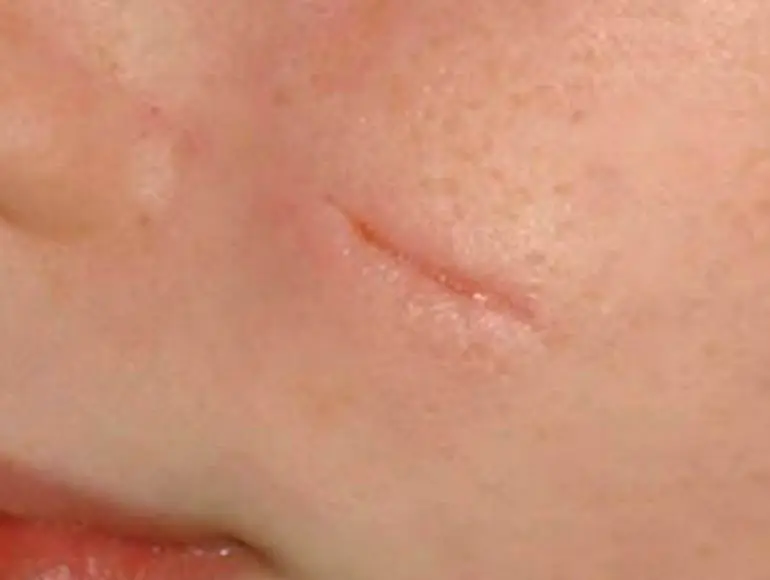
A keloid scar begins to form 2 weeks after the wound heals. The process may take several years. The skin changes color from red to pink, becomes rough and dense. Pain and itching may occur in this area. Then the discomfort goes away, and the skin around the scar becomes red, and the scar itself becomes lumpy and uneven. 3-5 years after the formation of the defect, a period of stabilization begins when no external changes are observed. Scars can increase under the influence of thermal or physical influences, or when they are damaged.
Causes of scar formation
After removing a mole, not everyone develops a scar. Typically, healing occurs in such a way that no traces remain at the site of damage. Deviations from the norm are caused by certain circumstances or characteristics of the body. If they are present, the process of cell regeneration is disrupted and leads to the formation of keloids and scars.
The main reasons for their formation include:
- deep or large damage to the epithelium;
- lack of vitamin C, oligoelements;
- disturbances in the functioning of the endocrine system;
- weakened immune system;
- presence of a tendency to allergic reactions;
- puberty;
- pregnancy;
- failure to comply with hygiene rules after surgery;
- infection that caused the inflammatory process;
- violation of precautionary measures;
- genetic predisposition.
The last reason is the most significant. Due to the presence of a predisposition, keloid scars form even with minor skin injuries.
Removal methods that avoid the risk of such consequences do not yet exist. Regardless of the method of eliminating the formation, there is a possibility of disturbances during the regeneration process.
Methods for treating scars after surgery
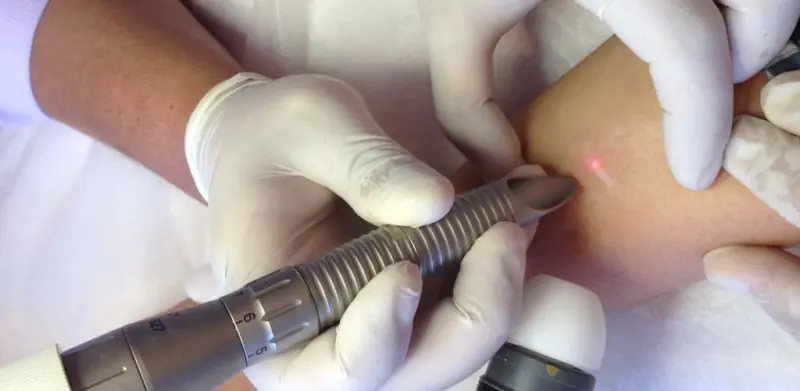
Special procedures help eliminate scars formed after mole removal. These include:
- Laser treatment. The laser action destroys dense fibers and stimulates the production of fibroblasts. Thanks to manipulation, the dermis is smoothed and new collagen is produced. It is possible to normalize the skin condition in 4-5 procedures.
- Dermabrasion. Scar polishing. During this process, the top layers of skin are removed. This is an aggressive but effective effect. After 3-5 sessions, it is possible to almost completely erase the scar.
- Injections. A collagen mixture or a corticosteroid drug is injected into the skin. The procedure slows down the formation of scar tissue and reduces the size of the scar. This method requires regularity.
- Physiotherapy. In this case, the use of phonoresis and electrophoresis is implied. These procedures are carried out using absorbable agents. Entering the skin, they smooth out the scar.
- Surgical intervention. This procedure is complex. During it, the scar is excised and healthy skin is transplanted. Carrying out requires high precision. It is allowed to be performed only one year after surgery to remove a mole.
- Medicinal influence. This method involves applying creams, gels and ointments to the damaged area. They need to be selected taking into account individual characteristics and used for a long time.
Attention! The method is chosen based on the specific situation. The doctor must study the clinical picture and features of the formed scar.
Scar creams
Special medicinal ointments and creams can help in the fight against scars. They increase the efficiency of procedures. The most commonly used include:
- Contractubex. The product softens the scar and has an anti-inflammatory and smoothing effect, relieves irritation and itching. It also slows down the proliferation of keloid fibroblasts. This ointment is applied to the scar three times a day. For old formations, it is recommended to apply compresses overnight.
- Kelo-cote. This drug has a silicone base. It has a softening and smoothing effect. Thanks to it, the growth of scars slows down, and the skin takes on a healthy appearance.
- Scarguard. This drug consists of hydrocortisone, silicone, vitamin E and tocopherol. The product is used to get rid of most of the unfavorable symptoms of skin diseases. It helps with itching and swelling, eliminates inflammation. Under the influence of the drug, cellular metabolic processes are activated.
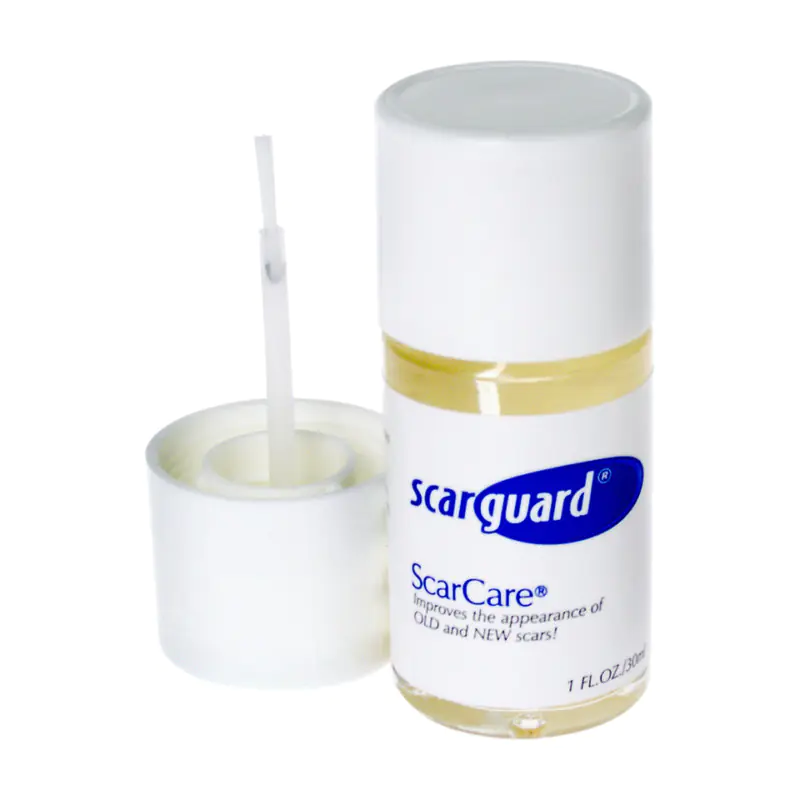
Prevention of scars after mole removal
Preventive measures do not guarantee that scars will not form after mole removal. But risks can be reduced by following these rules:
- Avoid injuring the crust formed after surgery.
- Treat the wound with disinfectants.
- Use acupressure in the area around the surgical intervention.
- If local healing agents are prescribed, follow their application regimen.
- Avoid visiting the solarium and sunbathing during the recovery period.
- Minimize the use of cosmetics during the recovery stage.



